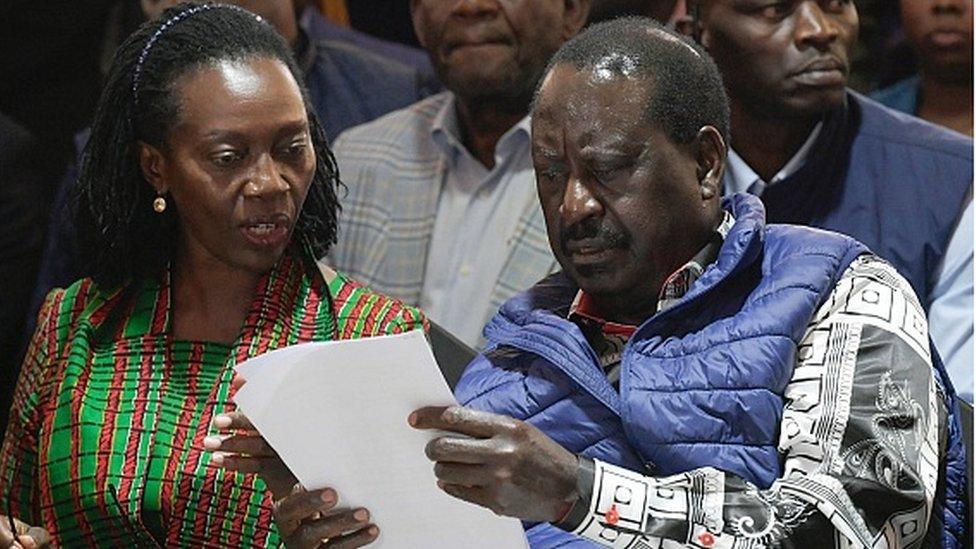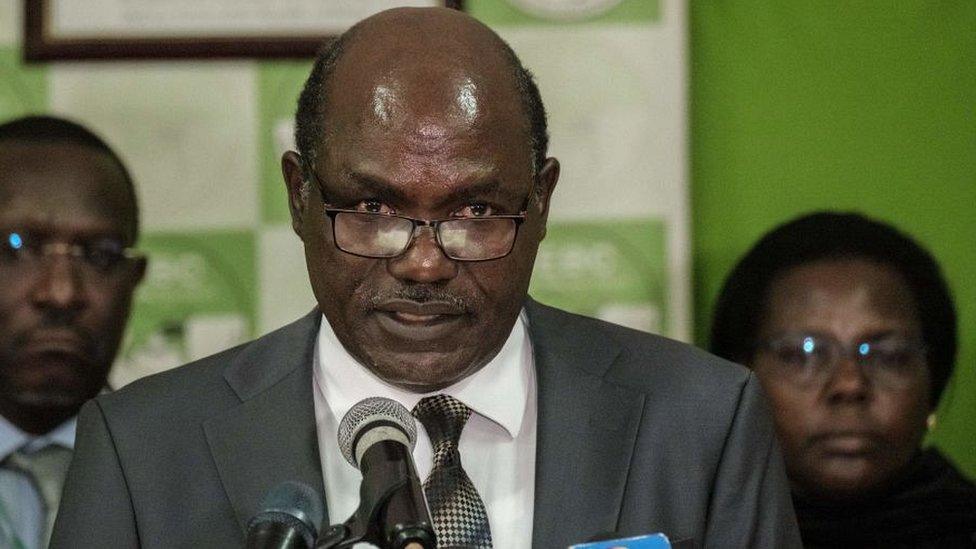Kenya election: What's the basis for Raila Odinga's challenge?
- Published

Defeated presidential candidate Raila Odinga with his running mate, Martha Karua
Raila Odinga, the losing presidential candidate in Kenya's recent elections, has filed a legal challenge to the result, in which William Ruto was declared the winner.
We've been looking into aspects of the legal case Mr Odinga has presented.
Did the chief of the election commission act improperly?
A key part of Raila Odinga's case hinges on the role of the chair of the Independent Election and Boundaries Commission (IEBC), Wafula Chebukati.

The legal complaint questions the actions of chief election commissioner, Wafula Chebukati
Mr Odinga says he should not have announced William Ruto as the winner without the agreement of a majority of the commission, and thus "usurped" their role.
We know that four of the seven commissioners did not support the announcement of the result. But there are different interpretations of Mr Chebukati's powers.
Some experts say that under the constitution, he alone is empowered to announce the outcome of the presidential poll, acting as the returning officer for that vote.
They also point to the fact that he has a legal obligation to do so within seven days of the date of the election. Mr Chebukati announced the results on 15 August, six days after the vote.
However, others argue that under Kenya's election rules, Mr Chebukati can only announce what the commission itself has "tallied and verified", something Mr Odinga says did not happen.
This is a point that the Supreme Court will have to resolve.
Were the online results hacked?
Mr Odinga's lawyers have filed testimony from anti-corruption campaigner John Githongo, in which he claims to have evidence of widespread, systematic manipulation of the computerised results database.
Mr Githongo says a source approached him with evidence that a team of more than 50 people worked to digitally alter results from counting stations in Mr Ruto's favour before uploading them onto the election commission website.
Mr Githongo says one of those involved was Dennis Itumbi, a digital strategist working for the declared winner of the election, William Ruto.
Reacting to the accusation on Twitter, Mr Itumbi has said: "The Fiction presented as a serious case! I am reading about myself in what sounds like a wild novel."
To verify if tampering of the declaration documents has taken place, the forms lodged with the electoral commission will have to be compared with the original hard copies of the forms completed by returning officers at local counting stations.
Is Mr Odinga correct about voter turnout discrepancies?
Mr Odinga's legal complaint also highlights what he says are inconsistencies in the official number of people who voted and the percentage given by the election officials for the overall turnout.

Kenyans queue up to vote on election day
Mr Chebukati had initially announced a turnout of 65.4%.
Mr Odinga says this turnout figure would mean 14.5m voters must have cast their ballots, based on the total number of registered voters.
The final official number of valid votes was 14.2m (and even if you add spoiled votes, you would get only around 14.3 million ballots cast), so Mr Odinga's legal team is claiming that "the commission is unable to account for over 250,000 votes that were cast in the election excluding voters who voted manually."
Mr Odinga's sums are correct. However, he's using a figure (65.4%) that Mr Chebukati shortly afterwards corrected to 64.6% - a figure which much more accurately reflects the actual voter turnout.
So Mr Odinga can argue that the election commissioner initially made a mistake, but this was quickly corrected by Mr Chebukati on the same day.
The final official turnout, once all the votes were tallied and verified, was 64.8% of the electorate.
Were there discrepancies in local level polls?
On election day, voters were not just electing a new president. They were also voting for governors, senators, MPs, women's representatives and members of county assemblies.
Mr Odinga says there were unexplained discrepancies in the total number of votes cast for different positions in the same areas.
He has cited Kirinyaga County in central Kenya, where he claims some 23,000 more people voted for the president than for the governor.
We can't be sure where Mr Odinga's figures have come from, or what might account for the difference.
But a live stream of the count shows that the returning officer failed to mention just over 22,000 votes for one of the candidates standing in the governor's election.
We confirmed this with a reporter who witnessed the count.
In other areas, Mr Odinga's team claims the votes for the president were actually lower than than those for other positions, which they say "is a practically improbable scenario."
Variations in the numbers of spoiled ballots might account for some of the difference. Also, prisoners are only allowed to vote for the president - and not for any other positions - but that wouldn't make a huge difference.
There may well turn out to be significant discrepancies, but at this stage it's not possible to identify these with any certainty as not all the data are available from the election commission.

ANALYSIS: Win or lose, why Kenya's election challenge matters
WILLIAM RUTO: How the outsider defied the odds
BATTLE LINES: Hustlers versus dynasties
IN CHARTS: A nation explained
READ MORE: Full coverage

